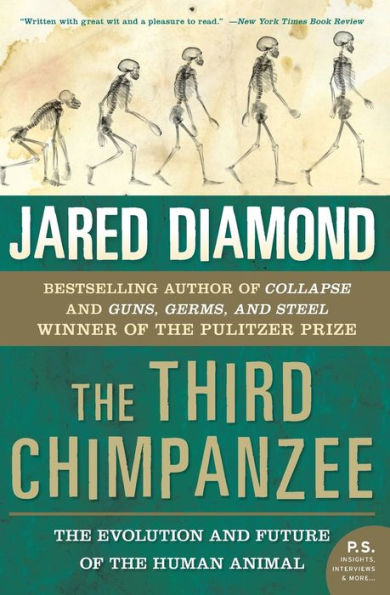Read an Excerpt
Part OneA Tale of
Three Chimps
The next time you visit a zoo, make a point of walking past the ape cages. Imagine that the apes had lost most of their hair, and imagine a cage nearby holding some unfortunate people who had no clothes and couldn't speak but were otherwise normal. Now try guessing how similar those apes are to us in their genes. For instance, would you guess that a chimpanzee shares 10 percent, 50 percent, or 99 percent of its genetic program with humans?
Then ask yourself why those apes are on exhibit in cages, and why other apes are being used for medical experiments, while it's not permissible to do either of those things to humans. Suppose it turned out that chimp genes were 99.9 percent identical to our genes, and that the important differences between humans and chimps were due to just a few genes. Would you still think it's okay to put chimps in cages and to experiment on them? Consider those unfortunate mentally defective people who have much less capacity to solve problems, to care for themselves, to communicate, to engage in social relationships, and to feel pain than do apes. What is the logic that forbids medical experiments on those people, but not on apes?
You might answer that apes are "animals," while humans are humans, and that's enough. An ethical code for treating humans shouldn't be extended to an "animal," no matter how similar its genes are to ours, and no matter what its capacity for social relationships or feeling pain. That's an arbitrary but at least self-consistent answer that can't be lightly dismissed. In that case, learning more about our ancestral relationships won't have any ethicalconsequences, but it will still satisfy our intellectual curiosity to understand where we come from. Every human society has felt a deep need to make sense of its origins, and has answered that need with its own story of the Creation. The Tale of Three Chimps is the Creation Story of our time.
For centuries it's been clear approximately where we fit into the animal kingdom. We are obviously mammals, the group of animals characterized by having hair, nursing their young, and other features. Among mammals we are obviously primates, the group of mammals including monkeys and apes. We share with other primates numerous traits lacking in most other mammals, such as flat fingernails and toenails rather than claws, hands for gripping, a thumb that can be opposed to the other four fingers, and a penis that hangs free rather than being attached to the abdomen. Already by the second century A.D., the Greek physician Galen deduced our approximate place in nature correctly when he dissected various animals and found that a monkey was "most similar to man in viscera, muscles, arteries, veins, nerves, and in the form of bones."
It's also easy to place us within the primates, among which we are obviously more similar to apes (the gibbons, orangutan, gorilla, and chimpanzees) than to monkeys. To name only one of the most visible signs, monkeys sport tails, which we lack along with apes. It's also clear that gibbons, with their small size and very long arms, are the most distinctive apes, and that orangutans, chimpanzees, gorillas, and humans are all more closely related to each other than any is to gibbons. But to go further with our relationships proves unexpectedly difficult. It has provoked an intense scientific debate, which revolves around three questions:
What is the detailed family tree of relationships among humans, the living apes, and extinct ancestral apes? For example, which of the living apes is our closest relative?
When did we and that closest living relative, whichever ape it is, last share a common ancestor?
What fraction of our genetic program do we share with that closest living relative?
At first, it would seem natural to assume that comparative anatomy had already solved the first of those three questions. We look especially like chimpanzees and gorillas, but differ from them in obvious features like our larger brains, upright posture, and much less body hair, as well as in many subtler points. However, on closer examination these anatomical facts aren't decisive. Depending on what anatomical characters one considers most important and how one interprets them, biologists differ as to whether we are most closely related to the orangutan (the minority view), with chimps and gorillas having branched off our family tree before we split off from orangutans, or whether we are instead closest to chimps and gorillas (the majority view), with the ancestors of orangutans having gone their separate way earlier.
Within the majority, most biologists have thought that gorillas and chimps are more like each other than either is like us, implying that we branched off before the gorillas and chimps diverged from each other. This conclusion reflects the commonsense view that chimps and gorillas can be lumped in a category termed "apes," while we're something different. However, it's also conceivable that we look distinct only because chimps and gorillas haven't changed much since we shared a common ancestor with them, while we were changing greatly in a few important and highly visible features like upright posture and brain size. In that case, humans might be most similar to gorillas, or humans might be most similar to chimps, or humans and gorillas and chimps might be roughly equidistant from each other in overall genetic makeup.
Thus, anatomists have continued to argue about the first question, the details of our family tree. Whichever tree one prefers, anatomical studies by themselves tell us nothing about the second and third questions, our time of divergence and genetic distance from apes. Perhaps, however, fossil evidence might in principle solve the questions of the correct ancestral tree and of dating, though not the question of genetic distance.



